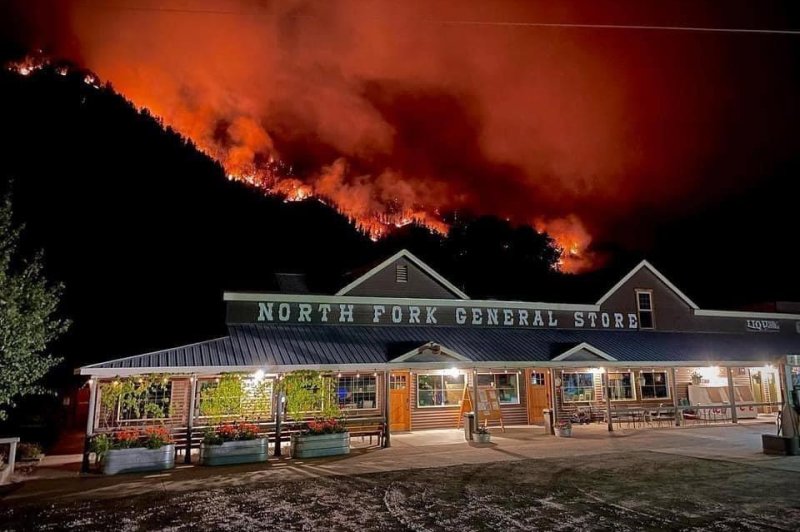July 31 (UPI) -- The raging McKinney Fire in northern California expanded Sunday after high winds caused by thunderstorms as Gov. Gavin Newsom declared a state of emergency for Siskiyou County.
While the California fire grew, fires in Montana and Idaho also expanded and crews in Hawaii were fighting a brush fire on Maui near Paia Bay.
In New Mexico, Gov. Michelle Lujan Grisham on Friday declared a state of emergency in the New Mexico town of Las Vegas after ash and flooding from the monstrous Calf Canyon/Hermit's Peak fire, which has been mostly contained, threatened its drinking water.
California's McKinney Fire has already burned up 51,468 acres in Klamath National Forest after it began Friday near the border with Oregon, the U.S. Forest Service said Sunday.
The cause of the fire is still under investigation, though a second fire named China 2 was started by a lightning strike and has burned more than 300 acres after merging with a third fire.
"Activity on both fires moderated into the evening as a heavy smoke inversion settled over the fire," the U.S. Forest Service said.
"The fire became active again at about midnight. Crews were actively engaged in structure protection overnight, especially in the Klamath River area. Little progression was observed on the fire's edge closest to Yreka City."
Officials said that 400 structures so far have been threatened by the fire and officials have prioritized structure preparation and protection along Highway 96 near the communities of Fort Jones and Yreka City.
"Firefighters continue direct suppression tactics when safe to do so and are looking at opportunities to build contingency lines should they become necessary," the U.S. Forest Service said.
"Containment lines from previous fires are being reopened even as firefighters work on the active edge of the fire."
Officials said that the area remains in a Red Flag Warning for a threat of dry lightning and strong outflow winds associated with thunder cells.
"These conditions can be extremely dangerous for firefighters, as winds can be erratic and extremely strong, causing fire to spread in any direction," the U.S. Forest Service said.
"New lightning fires are still being detected, including one overnight at the top of Doggett Creek north of the main fire. Crews will be assessing and addressing these fires as they are detected."
Gov. Newsom proclaimed a state of emergency for Siskiyou County because of the McKinney Fire, which he said has "destroyed homes, threatened critical infrastructure and forced the evacuation of almost 2,000 residents."
"A state of emergency allows for more flexibility in the face of an unfolding crisis, including the suspension of regulatory statutes that may impede the emergency response and recovery efforts. It also helps access federal aid and unlock certain state resources," Newsom said.
"This proclamation also triggers the Emergency Management Assistance Compact, allowing firefighting resources from other states to assist California crews in battling the fires."
In Montana, the human-caused Elmo 2 fire has burned more than 7,000 acres since it was started Friday around 8:30 p.m. local time, according to fire officials.
"It is currently managed as a Type 3 Incident with 214 personnel on site," fire officials said. "Fire behavior is extreme."
The Confederated Salish and Kootenai Tribes Division of Fire said in a statement that "the fire is consuming some thick standing and dead timber that has not seen fire in several decades."
"Hot and dry conditions combined with gusty winds will increase fire behavior. Heavy air tankers, S.E.A.T.s, helicopters and air attack will be used to stop the spread of the fire to the north and west," the officials said.
Officials added that some homes remain under evacuation orders and a temporary flight restriction has been placed in the airspace above the fire.
In Idaho, the Moose Fire, which started on July 17, has now burned more than 48,000 acres in the Salmon-Challis National Forest about 17 miles north of Salmon, Idaho.
U.S. Forest Service Law Enforcement and Investigations determined Saturday that the Moose Fire, which has now been 21% contained, was human caused.
"The specific cause and events leading up to the fire are still under investigation, and further information will be available as the inquiry unfolds," the U.S. Forest Service said.
Fire officials said that the region continues to be in "extreme fire danger" as hot and dry conditions continue with light winds. Residents in the area remain under evacuation orders.















